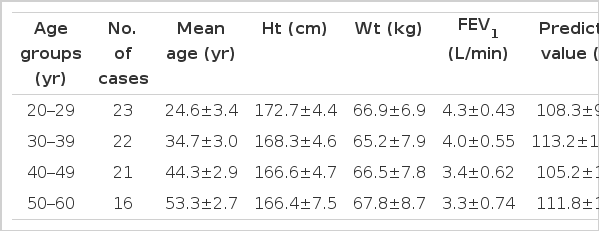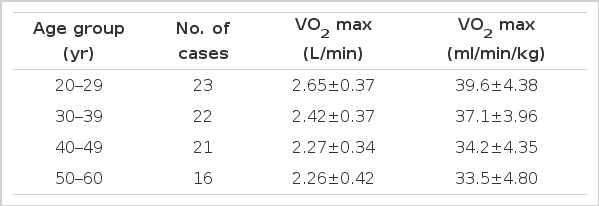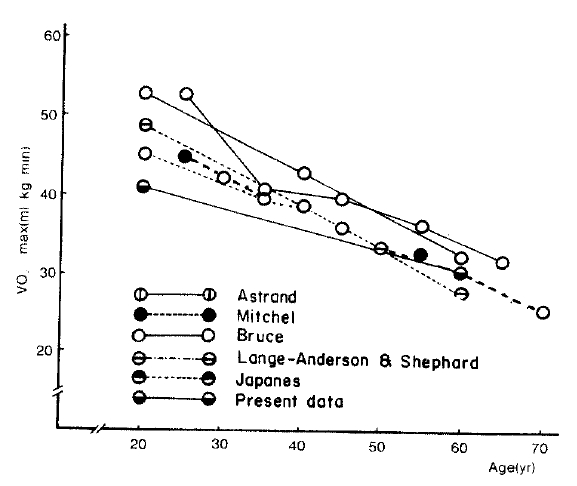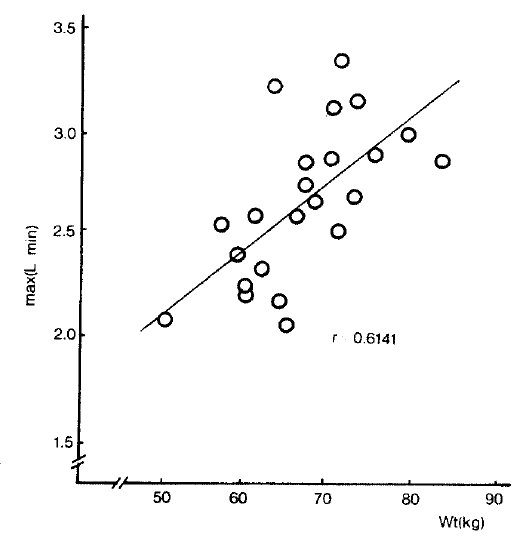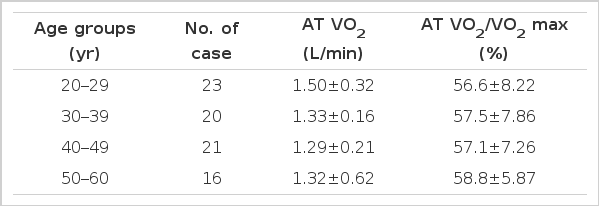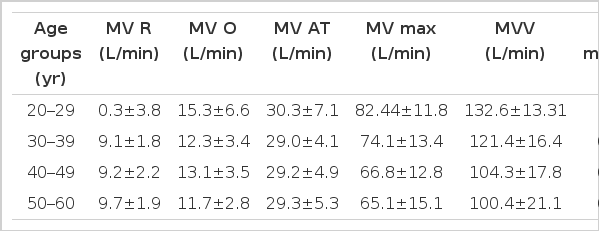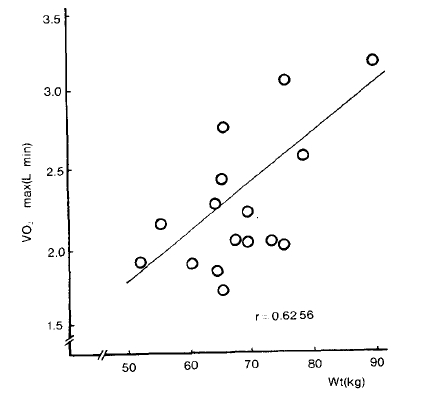The Stress Exercise Test and Oxygen Uptake in Normal Korean Men
Article information
Abstract
In order to observe physiologic responses to exercise and measure the normal value of maximal oxygen uptake, an exercise stress test, using a bicycle ergometer, was carried out on 82 normal males, 20 to 60 years of age.
The exercise test consisted of 1 minute of unloaded cycling with an increment of 25 watts each minute to the point of exhaustion. Oxygen uptake, anaerobic threshold(AT), minute ventilation, and CO2 output were measured with an automatic gas analyzer and a pneumotachograph during the exercise.
The results are summarized as follows:
The maximal oxygen uptake in the 20–29 year-old group of subjects was 39.6ml/min/kg, and it decreased with advancing age.
The anaerobic threshold was 1.22–1.5 L/min in all age groups. No significant differences by age were observed. The mean ratio of the anaerobic threshold to the maximal oxygen uptake was 57%.
The minute ventilation at maximal exercise was 65% of the maximal voluntary ventilation. This means that the subject cannot perform exercise at all, because of shortness of breath, that some potentially useful ventilation is left.
INTRODUCTION
It has been reported in some epidemiologic studies1,2) that an increase in physical activity reduces the incidence of hypertension and coronary mortality, and affects lipid and carbohydrate metabolism in a favorable way. In the present study, an effort was made to investigate physiologic responses to exercise and determine the normal values of maximal oxygen uptake in Korean subjects for objective measures of physical fitness.
When a person is subjected to progressively increasing work loads, there is a linear relation between work load and oxygen uptake until a plateau is reached, and, thereafter, despite the increasingly heavier work load, the oxygen uptake levels off or even declines. This turning point of oxygen uptake is known as maximal oxygen uptake. The maximal oxygen uptake is widely used as a useful tool for the evaluation of the functional capacity of the cardiovascular system to deliver oxygen to the tissues of the human body which has normal pulmonary function.3,4)
As the work load is increased, the oxgen requirement of the exercising muscles increases. However, after a certain increment in the work load, the oxygen transported to the muscle cannot meet the requirement. In this situation the anaerobic metabolism develops by the conversion of pyruvate to lactate in the muscle cells.
The increase of lactate is immediately buffered by bicarbonate with the release of carbon dioxide. The carbon dioxide generated in the buffering process changes the respiratory volume and the compartment of gas. As a consquence of the increase in carbon dioxide output, the rate of rise of ventilation is accelerated while the oxygen uptake remains linear. This level of oxygen uptake which accelerates the rise of ventilation is defined as the anaerobic threshold (AT) by Wasserman et al.,7) and this index is considered to be of value in evaluating physical fitness.
The maximal oxygen uptake can be measured by means of either a bicycle ergometer or a treadmill. The ergometer is commomly used in Europe, while the treadmill is used more in U.S.A.8) For the exercise loading, two methods are used: one, to increase the exercise load with small additions at one-minute intervals, and the other is to increase it with large additions at longer, 3–4 minute intervals. The former method is reported by Wasserman et al.5) to be more useful for the measurement of AT.
Values of maximal oxygen uptake and anaerobic threshold vary with age, 9,10) sex,11) and level of physical activity.12,13) There are many reports of studies done on exercise tests and oxygen uptake on normal persons and athletes in other countries.4,11,13–16) In Korea only a few investigators have reported the maximal oxygen uptake in only a few selected subjects.17–19)
It is the purpose of this study to measure normal values of maximal oxygen uptake and anaerobic threshold in a wide range of age groups and compile data which can be used in basic and clinical medicine.
SUBJECTS AND METHODS
1. Subjects
The subjects in our study were 82 Korean men, 20 to 60 years of age, who were clinically healthy and did not use drugs which might affect the test. The ECG and pulmonary function test of each of the subjects were within normal limits. The subjects were students, doctors, and office workers, who served as volunteers. All of the subjects were persons who were active in daily life; however, they were not athletes. The age, physique, and FEVI of the pulmonary function test of the subjects are given in Table 1.
2. Methods
Exercise test was done using a bicycle ergometer (Monark-Crescent AB CO., Switzerland) after one-and-one-half hours of fasting. The method of exercise loading consisted of 1 minute of pedaling on an unloaded cycle-ergometer at 50 rpm and increasing the work load by 25 watts every minute until the subjects reached the point of exhaustion.
The expired gas was collected via a mouthpiece and a Y-valve with the subjects noses closed with nose clips. The minute ventilation, oxygen uptake, and CO2 output were measured by a pneumotachograph and oxyscreen, and the results recorded every 30 seconds. During the exercise, the electrocardiogram was continuously monitored on the oscilloscope and the heart rate recorded every 30 seconds. Blood pressure was measured every minute at the time the work load was increased.
The anaerobic threshold was identified as the oxygen uptake when the ratio of minute ventilation/CO2 output did not increase.
RESULTS
1. Maximal Oxygen Uptake
1) Age and maximal oxygen uptake
The mean and standard deviations of maximal oxygen uptake are shown in Table 2. The maximal oxygen uptake was highest in the 20–29 year-old group and it decreased gradually with advancing age. Individual oxygen uptake in relation to age is given in Fig. 1a. Regression of the maximal oxygen uptake on age produces the following equation: maximal oxygen uptake (ml/kg/min) = 46.27 −0.26×age (year) (r=−0.5710, p<.01), which indicates a mean rate of decline of −0.26 ml/kg/min per year of age. The values of the maximal oxygen uptake in our study are compared, in Figure 1b, with data reported by other investigators.
2) Body weight and maximal oxygen uptake
The relation of maximal oxygen uptake to body weight is shown in Fig. 2a–d by age groups. The correlation coefficient between maximal oxygen uptake and body weight ranged from +0.5058 to +0.7075.
2. Anaerobic Threshold(AT)
AT was measured in 80 of the 82 subjects (Table 3 and Fig. 3). The value of the AT in 20–29 year-old-group was the highest of all of the age groups (p< .005). In the 30-, 40-, and 50-year-old-groups, no significant differences were observed. The mean ratio of AT to maximal oxygen uptake in all age groups (Fig. 4) was 57.5% (range: 43–77%).
3. Maximal Heart Rate
The mean maximal heart rate and heart rate at AT are shown in Table 4 and Fig. 5. Regression of maximal heart rate by age induced the following equation: maximal heart rate=208.77 − 0.33×age(y) (r=−0.6932, p<.01). The heart rate at AT was 73% (range 62–83%) of the maximal heart rate; this ratio is slightly higher (about 15%) than the ratio of AT to maximal oxygen uptake.
4. Minute Ventilation
The mean value of minute ventilation during rest and exercise, and the ratio of maximal minute ventilation to maximal voluntary ventilation are shown in Table 5. Minute ventilation increased gradually up to the point of AT and then accelerated after reaching AT. The mean ratio of minute ventilation at maximal exercise to maximal voluntary ventilation (FEV1×35) was 65% at all ages.
5. Heart Rate and Oxygen Uptake
The rates of increase of heart rate and oxygen uptake during exercise were almost linear. The regression equations between heart rate and oxygen uptake are as follows: oxygen uptake (ml/kg/min) = 0.31 × heart rate −20.69(r = 0.8834) in the 20-gears-of-age group, oxygen uptake = 0.31 × heart rate −21.34(r = 0.9412) in the 30-years-of age group, oxygen uptake = 0.34 × heart rate 23.39(r = 0.9401) in the 40-years-of-age group, oxygen uptake = 0,33 × heart rate −22.37(r = 0.8987) in the 50 years-of-age group.
6. Duration of Exercise
The twenty-years of-age group showed the longest exercise duration among all groups. The exercise duration tended to decrease with age (Table 6). The causes of the termination of exercise were leg pain in 75 subjects, exhaustion in 4 subjects, and dyspnea in 3 subjects. Ventricular premature contraction in 1 case and postexercise syncopal episode in one case were observed, with prompt recovery.
DISCUSSION
The oxygen uptake is dependent on both cardiac output and arteriovenous oxygen difference.4) It is reported that when the oxygen uptake increases from rest to maximal work load, the cardiac output increases by 4.3 times and the arteriovenous oxygen difference increases by 2.2 times. These findings indicate that the ability to increase cardiac output in normal individuals is the main factor in the determination of maxmal oxygen uptake.20) Cardiac output is defined as the product of stroke volume and heart rate. During exercise, the stroke volume increases slightly until heart rate reaches 120–130/min, and, thereafter, heart rate becomes the main determinant of cardiac output.21)
In normal individuals, differences in sex,11) age,9,10) habitual level of physical activity, physical conditioning,13,22) lean body mass,12) nutritional state,11) and hemoglobin level23) account for the physiologic variation in maximal oxygen uptake.
In this study, the 20-years-old group showed the highest value of maximal oxygen uptake. This diminished with the advance of age. The measured values of oxygen uptake in this study are slightly lower than those of other reports, such as those of Bruce,14) Astrand,11) Sue,16) Shephard.23) Lange-Anderson,23) Mitchell,4) and Mitsui.15) The differences are even greater in the younger age group as shown in Fig. 1b. Although the cause and significance of lower values of the maximal oxygen uptake are not clear, we assume that the difference in the exercise in the loading method and the lower motivation of our subjects may be contributory.
The causes of the decreasing maximal oxygen uptake in aging are the decline in maximal heart rate, muscle mass as replaced by connective tissues, and arterio-venous oxygen difference.24) The decrement rate of maximal oxygen uptake is greater in the sedentary person than in the physically active person. The rate of decrease was 0.26 ml/kg/min per added year of age in this study, which is smaller than the values reported by Dehn.9) The smaller decrement rate may be due to the cross-sectional design of our study or difference in the willlingness of the subjects to exercise to a maximal effort.
It is reported12) that oxygen uptake is positively correlated with body weight. The correlation coefficient between maximal oxygen uptake and body weight was calculated in this study, which confirmed the other results reported.
The cause of fatigue and muscle pain on exercise is the increase of lactate. When the exercising muscle is deficient in the supply of oxygen, the effect of anaerobic glycogenolysis with production of lactic acid, becomes evident. The increased formation of lactic acid produces metabolic acidosis and the lactic acid is buffered by bicarbonate. The additional carbon dioxide which is formed by this buffering process stimulates the ventilation and results in an increase in respiratory exchange ratio.24,26) Because these changes are a brief phenomenon occuring at certain work load, the one-minute incremental work test can detect these changes easily.5) The anaerobic threshold is the level of oxygen uptake at which the lactate increase becomes evident. Below the anaerobic threshold level one can, perform exercise for a long duration without fatigue.6,11,26) The mean anaerobic threshold in our study was 57.5% (range 43–77%) of maximal oxygen uptake which is similar to those of other reports. The level of the anaerobic threshold can be increased by endurance training and can be used as an index of physical fitness. The measurement of AT in the cardiac patient and the aged individual is considered to be very useful to evaluate the cardiovascular function of these individuals.27)
The ratio of heart rate at AT to maximal heart rate was 73% (range 62–83%). The heart rate at AT was 138.5/min in the 20-years-of-age group, 131.6/min in the 30-years-of-age group, 126.3/min in the 40-years-of-age group, 124.8/min in the 50-years-of-age group. It is assumed that the level of exercise below these heart rates can be performed for a long time without burdening the body.
To make the exercise test useful in clinical practice, the exercise should be safe and feasible to carry out within a short length of time. Since the value of maximal oxygen uptake increases as more muscles become involved in exercise, the value of the maximal oxygen uptake in the same person may vary according to the method of stress loading. Comparing bicycle ergometer and treadmill exercise, the value of maximal oxygen uptake which is measured by the latter is higher by 7–15% than that measured by the former.28,29) Since almost all of the muscle groups involved in doing the treadmill exercise, and on the other hand, only thigh and leg muscle groups are involved in doing the bicycle ergometer exercise, at the end point of the exercise there, are breathlessness or generalized fatigue in the treadmill exercise, and leg and thigh pain in the bicycle ergometer exercise.30) In most of the subjects cooperating in our bicycle ergometer study, there was leg pain, also at the end. We preferred the bicycle ergometer test because the maximal oxygen uptake as measured by the treadmill test might be dangerous in untrained individuals since the exercise is not purely voluntary and the bicycle ergometer test is less dependable on body weight.
In this study the minute ventilation during maximal exercise was 65% of the maximal voluntary ventilation at rest, which is in accord with other reports.16) This means that most of the subjects still had some reserve of ventilation when they stopped exercise. Conversely, this means that ventilation is not a limiting factor in exercise in normal subjects.
Since the measurement of oxygen uptake during exercise is relatively difficult in an ordinary medical clinic, the measurement of heart rate has been used as a substitute. Subsequently, we studied the correlation between the heart rate and oxygen uptake and our data showed that the correlation is relatively good between them.
